Here you can find out everything you need to know about Plants, for duck and for preparation of nutmeg should know.
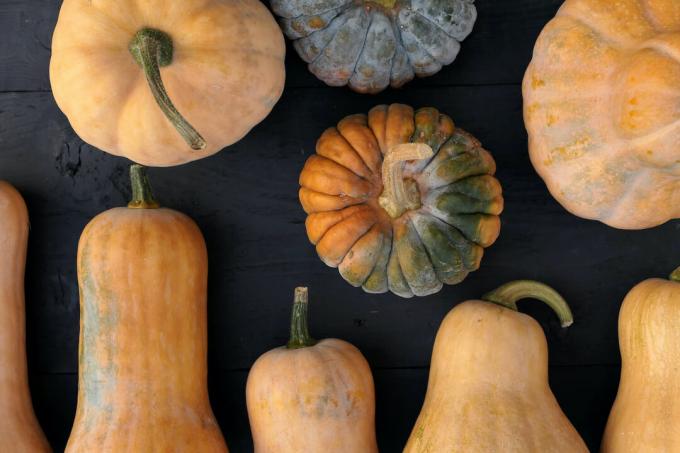
The Nutmeg Squashes (Cucurbita moschata) form a subspecies in the pumpkin family (Cucurbitaceae). A well-known representative is the popular one Butternut Squash. The warmth-loving little plants make some demands, but can also be grown in Germany under good conditions. We will show you what you should pay attention to.
Contents
- Nutmeg: appearance, properties and origin
- The most beautiful varieties
- Plant nutmeg squash
- The right care
- Harvest nutmeg
- Preparation of the nutmeg pumpkin
Nutmeg: appearance, properties and origin
Nutmeg pumpkins have flattened, ribbed to pear- or cylindrical-shaped, smooth fruits. The skin typically comes in shades of orange, yellow, and green. The nutmeg pumpkin skin often changes its color, which indicates the respective degree of ripeness of the pumpkin. A color change from green to beige-brown to orange can often be observed. The pulp of the nutmeg pumpkin is traditionally orange and has an aromatic taste and a melon-like smell. The nutmeg pumpkin originally comes from Central and South America. It has been native to Peru and Mexico for 4000 years. Therefore, it can already be guessed that the plants prefer a warm, humid climate. In Central Europe they thrive best in the wine-growing climate.
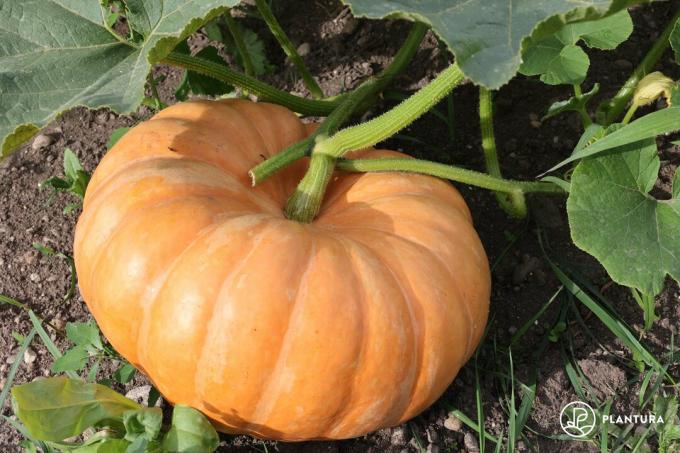
If you cultivate the plant, also known as "musk gourd", in Germany, you will probably harvest fruit weighing a maximum of 5 kg. In the tropics and subtropics, on the other hand, they can weigh up to 40 kg. As a result, the pumpkins are usually sold in the shops in pieces and not as a whole. They reach a diameter of up to 50 cm and have a cylindrical, pear-shaped, spherical or classically broadly flattened shape with deep ribs. The foliage of the annual plant consists of rounded to heart-shaped, dark green leaves. Butternut squash often have silvery to white spots. Both the leaf green and the shoots are downy hairy.
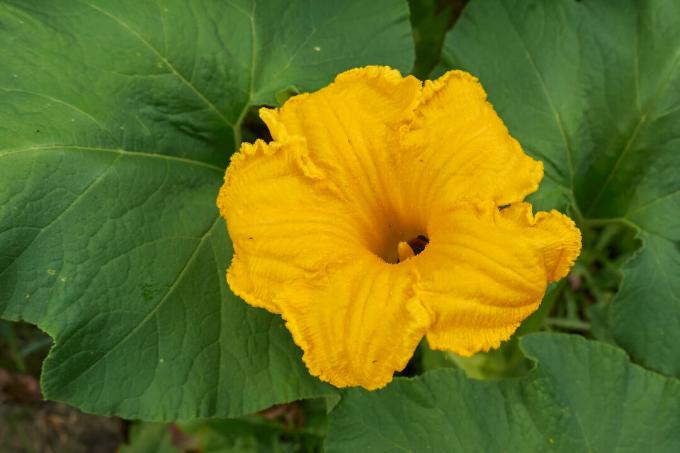
The flowers typical of cucurbits are bell-shaped and yellow to orange. They bloom from June to July. In addition, they are bee-friendly and occur as purely male and female flowers on a plant. This is referred to as monotony. The nutmeg subspecies is one of the more demanding varieties in terms of location, nutrient and water supply. They only reach harvest maturity if their requirements are met. If the fruits thrive as desired, they will ripen after 4 to 5 months, depending on the variety, and will have a good shelf life.
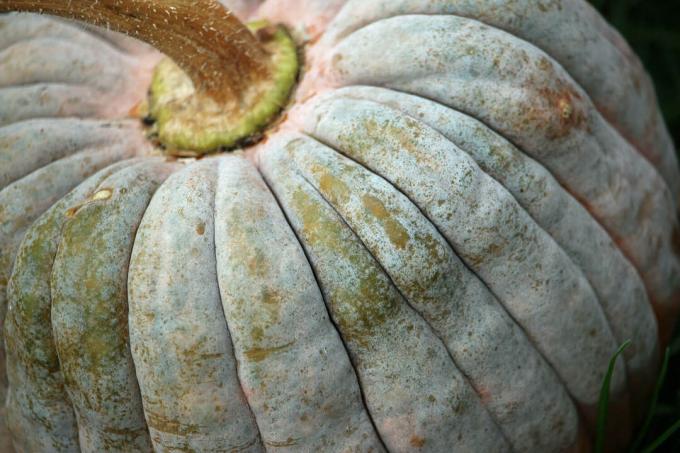
The most beautiful varieties
The group of nutmeg pumpkins includes a large number of varieties. So there is something for every pumpkin lover. For example, you have the choice between a large fruit and a mini nutmeg pumpkin.
- ‘Muscade de Provence': Large, flat-round and deeply ribbed fruits weighing about 5 - 18 kg; color transition of the shell from dark green to light brown; robust, likes warmth and very productive; delicate taste; rather late ripening.
- ‘mini musk‘: Smaller, broadly flattened fruits weighing 2 – 5 kg; smaller variant of 'Muscade de Provence'; skin green-blue to orange depending on degree of ripeness; sweet, full-bodied taste; mean ripening time.
- ‘Musquee de Maroc‘: Medium-sized, round to slightly flattened fruits weighing 3 to 5 kg; Skin changes color from dark green to terracotta at maturity; strong climbing; sweet taste; tolerant to powdery mildew; rather precocious.
- ‘Futsu Black‘: Smaller fruits with 1 – 3.5 kg; broad flattened shape; skin dark green to terracotta depending on degree of ripeness; dark patina towards harvest maturity; fruity taste; mean ripening time.
- 'Chirimen': Medium-sized fruits weighing 5 – 10 kg; flat round shape; color transition of the shell from black-blue to orange-bronze; strong climbing; fruity taste; rather precocious.
- 'shishigatani': Small, pear-shaped fruits weighing 0.2 - 2 kg; Shell color change from black-dark green to light brown; strong climbing; sweet pulp; mean ripening time.
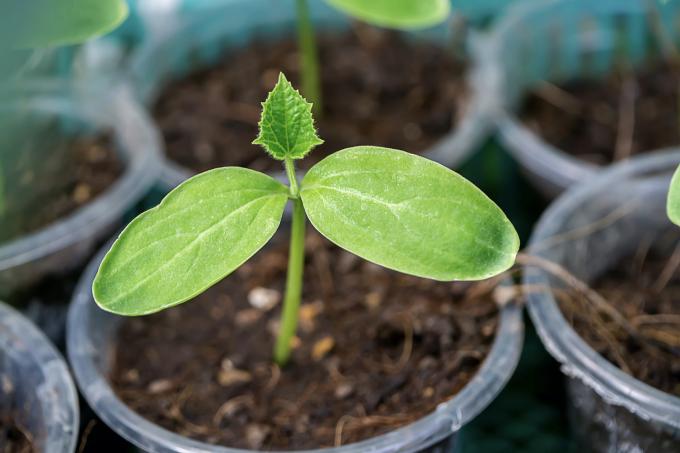
Plant nutmeg squash
If you want to cultivate nutmeg pumpkins yourself and you don't happen to live in a wine-growing region, the seeds should definitely be grown on the windowsill. Preculture is possible from mid-April. To accelerate germination, it is advisable to soak the seeds in lukewarm water or camomile tea about 24 hours before sowing. Chamomile creates additional benefits with its antibacterial and antifungal effects. In order to promote the root formation of the seedlings, you should first use a low-nutrient potting soil such as ours Plantura Organic Herb & Seed Soil be used. Now bring 2 to 3 seeds together in a seed pot about 3 cm deep into the ground and water carefully. The pots should now remain in the apartment at 22 to 26 °C with permanently moist soil and plenty of daylight for the coming weeks. After germination, which is normally after 6 to 12 days, only the strongest young plant is allowed to continue growing. This is pricked when the first correct pair of leaves appears. Now it makes sense to mix nutrient-rich soil under the potting soil to meet the high nutrient requirements of the pumpkins.
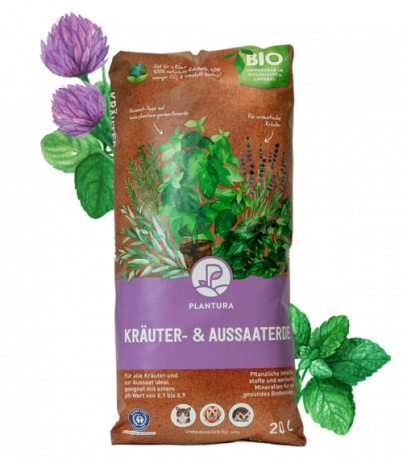
Organic Herb & Sowing Soil 20 L
- Ideal for herbs as well as for sowing, propagating cuttings and pricking out
- Ensures aromatic herbs & strong young plants with strong roots
- Peat-free & climate-friendly: CO2-reduced organic soil made in Germany
The nutmeg pumpkin seedlings should only be planted outdoors from mid-May, after the ice saints. A suitable choice of location is particularly important for the development of the musk gourds. Choose a spot that is as sunny as possible but protected from the wind. The soil should heat up quickly here, so it shouldn't be too heavy, and still be able to hold water. However, waterlogging must be avoided at all costs. A loose substrate with a lot of organic matter is ideal. Overall, a loamy sand or sandy loam is best.
It is also important to note that pumpkins are generally not like themselves and other cucurbits zucchini (Cucurbita pepo subsp. pepo convar. giromontiina), cucumbers (Cucumis sativus) and melons are compatible. Thus, a cultivation break of 3 to 4 years between the cultures should always be observed at one point. This is an efficient method to combat soil-borne pests. If you want more on the subject crop rotation If you want to know more, you can read our separate article. Since pumpkins are heavy feeders, it is advisable to enrich the soil with compost, stored manure or a predominantly organic long-term fertilizer before planting. In addition, the nutmeg should not be planted next to other heavy feeders or cucurbits. If you plant it in the bed, you should handle the young plants carefully so as not to damage the sensitive shoots. The musk gourds have a high space requirement of up to 3 m2. There should also be a distance of 50 to 80 cm between the plants.
Tip: In order to acclimate the small plants to the high sun exposure and less comfortable outdoor conditions, they should be gradually hardened off before planting out. To do this, you put them outside in the morning for a few days and put them back in the apartment in the evening. If you do without hardening, there is a quick risk of sunburn.
The right care
It is advisable to weed out unwanted weeds at the beginning of cultivation in order to prevent competition for water, light and nutrients. This should be repeated if necessary in the first few weeks of planting. Later, they cover the ground well with their tendrils and leaves, keeping wild herbs away.
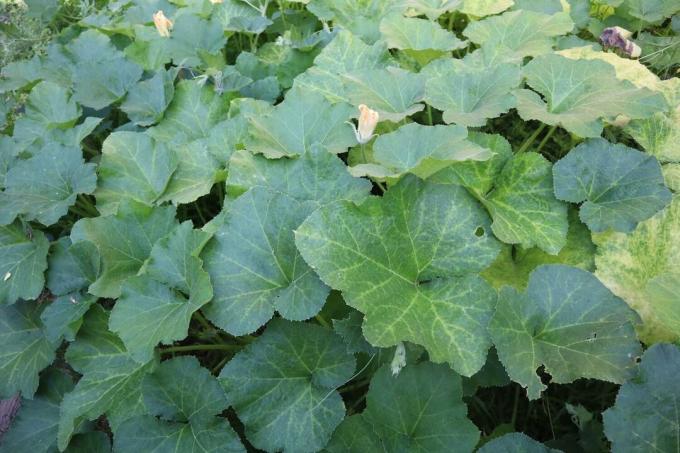
Since the little plants can develop best at temperatures above 12 °C, they should be covered with translucent foil or fleece on colder days. In order to get the most beautiful and large pumpkin fruits possible, only 2 to 3 fruits per plant should ripen in the case of large-fruited varieties. Small-fruited varieties, on the other hand, can easily bring up to 5 fruits to maturity. To achieve this, the shoots are shortened after pollination so that the desired number of pumpkin fruits is preserved.
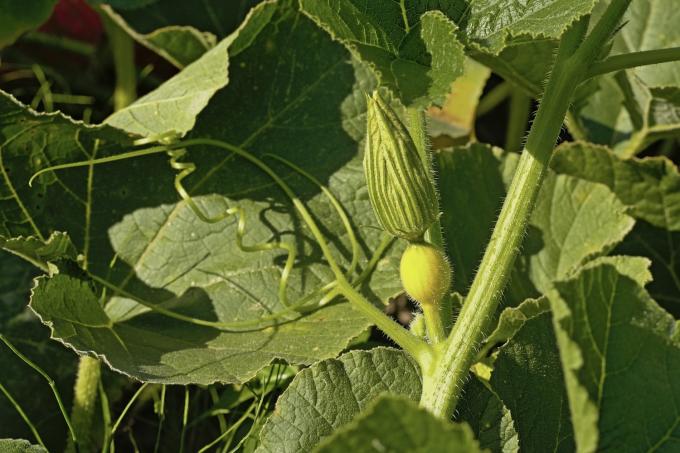
Proper watering is one of the most important factors when growing pumpkins. Ideally, you water with lukewarm rainwater and do not wet the leaves with water, otherwise the risk of downy mildew (Peronosporaceae) increases. In general, the soil should never dry out completely. It should therefore be watered once a day when it is warm and several times a day when it is hot. It is also advisable to water in the evening or early in the morning, as the water does not evaporate immediately and can be better absorbed by the plant.
Another way to control evaporation is to mulch. Mulch also helps keep the pumpkins dry and protects them from rot. Straw or lawn clippings are well suited as mulch material.
During fruit growth it is important that the plants are supplied with sufficient nutrients. In order to keep the effort as low as possible, it is advisable to use a long-term fertilizer. Since the flat roots of the pumpkins are sensitive to salt, organic fertilizers should be used here. Mineral nitrogen fertilizers are water soluble and often highly concentrated, damaging pumpkin roots. If you have already enriched the soil with fertilizer before planting, a fertilizer application during growth is usually sufficient. Our Plantura organic tomato fertilizer is a potassium-rich long-term fertilizer and thus has a positive influence on the fruit quality of the nutmeg pumpkins. It is slowly and gently released by soil organisms over several weeks, so there is no risk of over-fertilization.
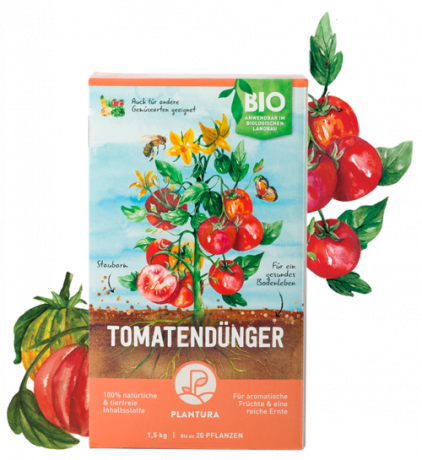
Organic tomato fertilizer 1.5 kg
- Ideal for tomatoes, chili, zucchini, cucumber & Co.
- For stronger plants & an aromatic, rich harvest
- Animal-free organic slow-release fertilizer - safe for pets and garden animals
With very high solar radiation there is a risk of cracks in the shell. You can counteract this by covering the fruit with damp cloths on sunny days. Unfortunately, snails also like nutmeg pumpkins. If there are only a few, it is sufficient to collect them. In the case of a larger infestation, however, you can use a snail fence. If you want to learn more about this, you can read our special article on the Snail fence with tips for building it yourself read. A more convenient way to take action against the pests is to use slug pellets. Our Plantura organic slug pellets is based on the active ingredient iron-III-phosphate and is gentle on pets and beneficial insects. The treated vegetables can be consumed without restrictions.
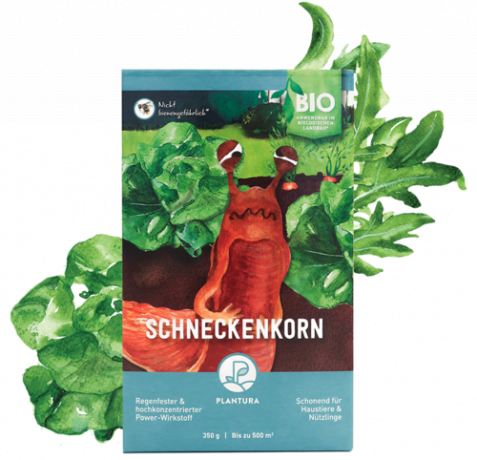
Organic slug pellets with powerful active ingredient for 500 m²
- Rainproof & highly concentrated power active ingredient: fights slugs on vegetables & fruit extremely reliably
- Control without traces of slime and dead snails in the bed
- Gentle on pets and beneficial insects - applicable in organic farming
Harvest nutmeg
You can harvest your nutmeg squash when the stalk is already lignified. This is usually the case about 5 to 6 months after sowing. Harvesting must be done before the first frost, so the latest harvest time is usually early November. Since the stalk protects the pumpkin from pathogens, part of it should always remain on the fruit when harvesting. This is carefully cut off with a sharp knife, as even small injuries can severely impair the storability and lead to rot and mold. With good storage conditions, on the other hand, a nutmeg pumpkin can even be stored for more than half a year. A cool place with a temperature of 10 to 15 °C and good ventilation is suitable.
What does a ripe nutmeg squash look like?
As described above, the nutmeg pumpkin goes through different colors during its ripening, depending on the variety. When ripe, for example, the well-known pumpkin variety 'Muscade de Provence' has an external orange colour. However, some nutmeg squash lovers believe that a fruit that is not quite ripe tastes best. The skin of the nutmeg pumpkin is then still dark green. Harvesting when unripe, however, has a negative effect on storability. If you want to store your squash for a long time, the skin should be hard and the squash should be fully ripe. The tapping test is a good way to check whether a pumpkin is ripe. To do this, tap the fruit lightly with your knuckle. When a hollow sound is heard, the squash is ripe.
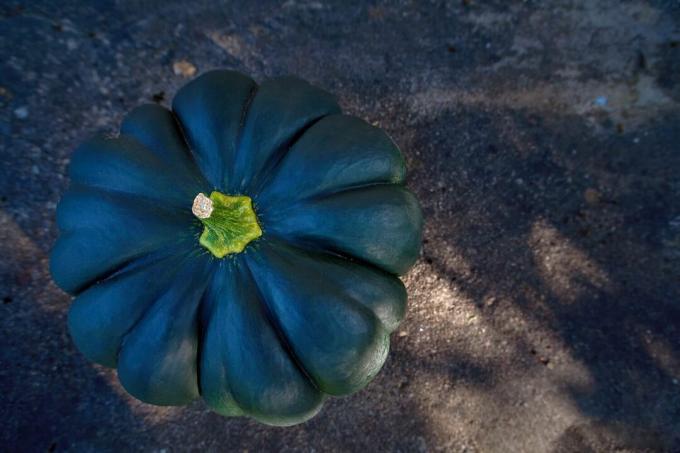
Preparation of the nutmeg pumpkin
The nutmeg pumpkin is known for its fruity-sour taste and for its nutmeg note. Because of these properties, it is recommended for chutneys. Although the skin of the nutmeg squash is edible if it is cooked long enough, it is time-consuming. So it is usually more practical to peel the pumpkin. If the fruit is large, you should first carefully cut the nutmeg into wedges with a sharp knife and then remove the peel. If you want to cook with your nutmeg, dishes such as soups and gratins are ideal. This is where its aroma comes into its own. But you can also prepare other dishes such as oven vegetables, pumpkin gnocchi or pumpkin pie from a nutmeg pumpkin. The nutmeg note of the pumpkin is brought out even more by seasoning with nutmeg. Because of the size, the squash can be difficult to process before it goes bad. This can be remedied by canning or freezing the nutmeg pumpkin.
In addition to the pulp, its flowers, leaves and seeds are edible. The nutmeg pumpkin is considered to be very healthy, mainly because of its high proportion of beta-carotene, the precursor of vitamin A. This has a positive effect on skin, hair and eyesight. In addition, it is said to have a strengthening effect on the immune system and the potassium it contains is said to lower blood pressure. In addition, with around 19 kcal per 100 g, it has very few calories.
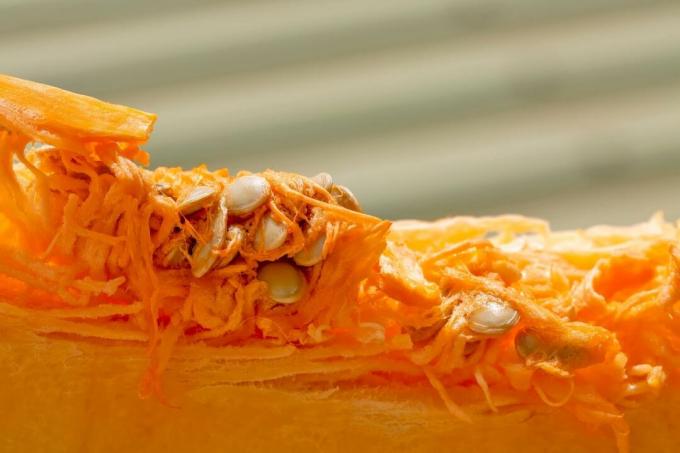
If you want to learn more about pumpkins, check out our article on the different types pumpkin varieties. There you will get to know not only edible, but also ornamental pumpkins.
Secure a 10% welcome discount for our online shop and receive great tips, seasonal trends and inspiration from our garden experts every week.



